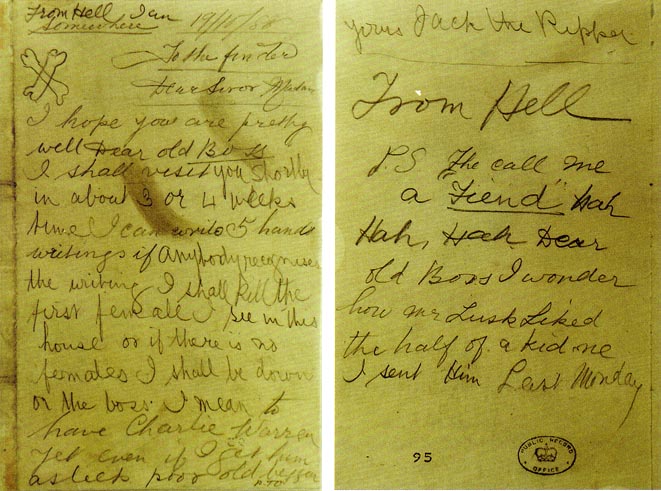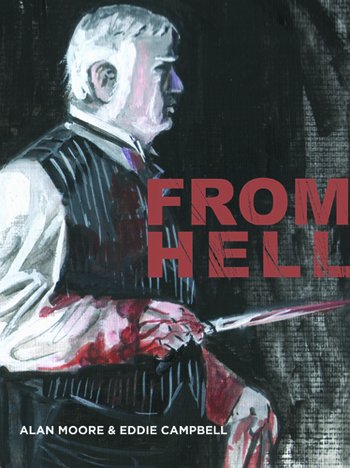Jack the Ripper
Before I begin I would like to explain that I am no expert or 'Ripperologist' I am simply interested in this case and have done very limited research into the events that follow. This is 'Jack the Ripper' for beginners so to speak. I have even linked some websites in that should help and this is a good place to start for more information: Casebook
Ever since I can remember I have had a weird obsession with 'Jack the Ripper'. In fact I know when it was. I was 11 years old and I went to the London Dungeons where there was an actor playing the part of 'Jack the Ripper'. He took us on a 'tour of London' and showed us the 'Ripper' sites. At each stop along the way he told the story of what happened to each victim. Obviously this was in a way that would make us squirm, but the real details are even worse. I was chosen to be the last victim, Mary Kelly. My body was 'mutilated' and my entrails removed. What actually happened to this poor woman was a lot worse (more detail later, but basically she was the last victim and the only one attacked at home where her breasts were removed and her entrails cut out with some surgical skill - picture below - only the link though so you don't have to see it if you don't want to but this is the original police photo).
Mary Kelly as found by police on 9 November 1888
As I say, I have been fascinated by Jack the Ripper and this year is the 125th anniversary of the events. In fact tomorrow (9 November) marks the 125th year since Mary Kelly was discovered. I have been fascinated how this one serial killer out of so many could become so famous. In context of the time and place, murder was a daily event.
This blog is not going to try and figure out who the killer was, rather why the story became so popular. There are countless reasons behind the popularity of 'Jack the Ripper' and here are just some.
Victims:
Generally when talking about 'Jack the Ripper' we mean the 'cannon five' murders of prostitutes between August and November 1888:
Method:
However, a kidney displaying signs of Brights disease was received by George Lusk, who was head of the vigilance committee in Whitechapel. Eddowes was the victim missing a kidney and was known to have Brights disease. The evidence has since shown inaccuracies so it is still uncertain as to the validity of the letter and kidney.
Ever since I can remember I have had a weird obsession with 'Jack the Ripper'. In fact I know when it was. I was 11 years old and I went to the London Dungeons where there was an actor playing the part of 'Jack the Ripper'. He took us on a 'tour of London' and showed us the 'Ripper' sites. At each stop along the way he told the story of what happened to each victim. Obviously this was in a way that would make us squirm, but the real details are even worse. I was chosen to be the last victim, Mary Kelly. My body was 'mutilated' and my entrails removed. What actually happened to this poor woman was a lot worse (more detail later, but basically she was the last victim and the only one attacked at home where her breasts were removed and her entrails cut out with some surgical skill - picture below - only the link though so you don't have to see it if you don't want to but this is the original police photo).
Mary Kelly as found by police on 9 November 1888
As I say, I have been fascinated by Jack the Ripper and this year is the 125th anniversary of the events. In fact tomorrow (9 November) marks the 125th year since Mary Kelly was discovered. I have been fascinated how this one serial killer out of so many could become so famous. In context of the time and place, murder was a daily event.
This blog is not going to try and figure out who the killer was, rather why the story became so popular. There are countless reasons behind the popularity of 'Jack the Ripper' and here are just some.
- The general populace had become literate and the press desired social change. 'Jack' had murdered prostitutes at a politically volatile time. The East end of London was a hotbed of crime and social injustice. On top of this rebellion in Ireland was beginning. The ordinary people were starting to demand better for themselves. Liberals, social reformers and Home Rule partisans were using crimes for their own ends. This drove the murders to the front of everybody's consciousness. On top of this there was an influx of Irish immigrants and also Jews from Tsarist Russia and Eastern Europe who were escaping persecution.
- The press was a driving force and more ordinary people were reading the news. Sensationalist and grisly pieces were popular for the first time and the 'Ripper' murders were just what the public wanted. This helped to create the 'Ripper' myths of today.
- The murderer also wanted to create a myth or an image of themselves by leaving all but one of the victims in public places and in disturbing poses with gruesome injuries. This caught the attention of many and created a 'Bogey Man' for the late 19th century.
- The 'Ripper' was never caught. As soon as the murders began, they stopped. There were similar, almost 'copy cat' murders following the 'cannon five' and these may have been the same murderer, but there is little evidence of this. The mysterious 'disappearance' of the 'Ripper' means even today there is a puzzle to solve.
 |
| Example of a newspaper telling the story at the time |
Generally when talking about 'Jack the Ripper' we mean the 'cannon five' murders of prostitutes between August and November 1888:
- Mary Ann (Polly) Nichols - Friday 31 August 1888
- Annie Chapman - Saturday 8 September 1888
- Elizabeth Stride - Sunday 30 September 1888 (Part of 'double event')
- Catherine Eddowes - Sunday 30 September 1888 (Part of 'double event')
- Mary Jane Kelly - Friday 9 November 1888
 |
| Death Certificate of Martha Tabram |
The method of murder helped create the popularity at the time around 'Jack the Ripper'. All victims were strangled and were left facing the same direction. Their throats were cut once they were on the ground. There is no sign that the attacks were ever sexually motivated. One victim had a kidney cleanly removed from the front and another had the sexual organs removed with a clean cut which suggests some anatomical knowledge. In every case some part of the victim was taken as a 'trophy'.
'Ripper Letters':
On 25 September 1888 the Central News Agency received a letter supposedly from 'Jack the Ripper' (where the name comes from in fact). A follow up letter was received on 27 September. A letter post marked 1 October referred to a "double event" which was not widely known following the two murders on 30 September so police believed it could be genuine at the time. Evidence has since suggested that the letters were the work of a journalist.
 |
| Example of a 'Ripper' letter - notice 'From Hell' the phrase is now synonymous with 'Jack the Ripper' |
Police involvement:
There was no DNA evidence or finger printing at the time so a person had to pretty much be caught in the act to be charged with murder. The main problem appears to be that two police forces had to be involved. Scotland Yard covered all London Boroughs except The City of London. Eddowes was murdered in The City of London and as a result the two forces failed to share evidence an important information coming from the "double event". The City of London Police took photos of Eddowes and (even though not in their duristiction) Kelly. If involved sooner, one wonders what other evidence they would have picked up and pieced together?
Suspects:
- M.J. Druitt - barrister turned teacher who committed suicide in December 1888.
- Severin Klosowski a.k.a George Chapman - only evidence came from a crack detective. No police officer agreed that Klosowski/Chapman was a suspect in their investigations.
- Aaron Kosminiski - fitted various police ideas of the murderer being a Polish Jew. Kosminiski was locked in an insane asylum, but he was pretty harmless and may have been confused with a patient of a similar name who was dangerous.
- Michael Ostrog - since believed to be just a demented con man.
- Dr Francis Tumblety - only known since 1993. A letter from Scotland Yard suggested a 'Dr. T' as a suspect who was 'an American Quack named Tumblety'. This suspect 'fled' to America and no serious investigation took place.
I only added the suspects to give closure to the 'Ripper' story. No suspect was ever charged. Why? Maybe through lack of evidence. Maybe because of the profession of the victims. Who knows?
The story continues to intrigue and fall into popular consciousness. From Hell was written by Alan Moore as a graphic novel and published as a serial from 1989 - 1996. This follows the idea that it was surgeon Sir William Gull who was responsible for the murders (in short he was Queen Victoria's physician and was linked in the 1970s (although there are earlier stories from shortly after his death) to a Freemason conspiracy to commit the murders, actually he should be credited with some amazing medical discoveries and outstanding work on cases such as anorexia nervosa and Bright's disease (yup as in the disease Eddowes had) plus women in medicine).
In 2001 the story was made into a film starring Johnny Depp and Ian Holm (who played Gull).
Trailer for the film version of From Hell
What this shows is that 125 years after the event the story still shocks and intrigues. This was a start to our morbid fascination with serial killers today and remains one of Victorian Britain's biggest puzzles.

Comments
Post a Comment